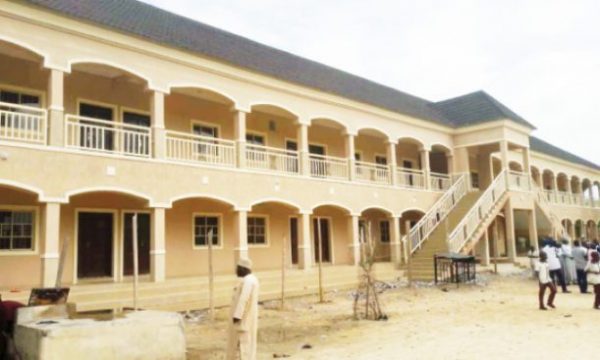It was the last place in Nigeria that I expected to find the most beautiful public schools, cutting edge health equipment, a lush housing estate and an industrial park humming with activity. Most stories out of Borno in the last decade were about insurgency, bomb blasts and IDPs, plus rent driven through the roof by local and international NGO spending.
Weeks ago when I first saw pictures of the new Mega Primary Schools that Borno State Government was said to have built, I wondered if it was photoshopped. I had a rethink only when I saw television pictures of President Muhammadu Buhari visiting Borno and commissioning some of the projects. I had further cause for rethink when the austere Buhari, not known for showering praise on anything, turned to Governor Kashim Shettima at Maiduguri Airport and said, “Allah yayi maka albarka [May Allah bless you].”
Maybe BOSG got wind of my skepticism; I got to see these projects nine days ago as part of a hastily arranged media tour. A public primary school in Northern Nigeria is typically an eyesore, made up of a building with cracked walls, no ceiling, leaking roofs, no doors or windows and with sand or boulders serving as seats for the pupils. In the event, Borno’s gleaming new Mega Primary Schools were a visual and cultural shock to me. When we walked into the first one, the Yemi Osinbajo Primary School at Bolori, it had three sparkling new storey blocks with 60 air-conditioned classrooms, each fitted with beautiful plastic desks and chairs.
I suffered a bigger cultural shock when a teacher, one of several hundred that BOSG recently retrained in India, stepped forward and switched on K-YAN, a Chinese digital teaching aid. It has been customized with local curriculum, and the teacher demonstrated how, with a touch of buttons, his words to the pupils were rapidly augmented with visuals with ample choices of colour, space, format and font size. To boot, the school has a fine library, a spacious playground and a large dining hall where a meal is served to each student every day. The only time my primary school gave me a free meal was on one occasion in 1970.
We visited seven more schools over the next few hours, named respectively after Babagana Kingibe and Ali Modu Sheriff, both at Ngomari; Mala Kachallah and Asheikh Jarma, both at Bulumkutu; Aliko Dangote Academy, named in honour of the business titan; Aisha Buhari Primary School at New GRA, and finally the grand Muhammadu Buhari Academy at Baga Road. Each school sported many storey buildings of gleaming multi colours, spacious play grounds, large halls and dormitory blocs. At Bulumkutu, which I first visited in 1982 not long after the deadly Maitatsine crisis, swamps that once dotted the area have given way to Mega Schools and a fabulous new mosque. As we stepped into each school, the lanky Commissioner for Education Musa Inuwa Kubo rushed to the front and gave a quick demonstration of its facilities. These fantastic schools are not meant for elite children but for war orphans and the children of pastoralists also sent packing by Boko Haram.
How did these amazing public schools pop up in Borno, which hosted the world’s deadliest anti-Western education insurgent group? Governor Kashim Shettima cited the Chinese word weiji, which means crisis. It is however written with two brush strokes, one meaning danger, the second meaning opportunity. Borno State, he said, has 52,000 orphans and 54,000 widows from the Boko Haram crisis. Thousands of children arrived in IDP camps unaccompanied because the insurgents killed their parents and took away their siblings. They are now the government’s children, Shettima said; “If we do not take care of them, in years to come they will take care of us.”
Borno State, he also said, has seven tertiary institutions and numerous public secondary schools but like most states, had badly managed its primary schools. He said, “The major problem of basic education in Northern Nigeria is the quality of our primary schools in terms of learning facilities, number of pupils per class, quality of teachers and efficiency of supervision.” He said while public school teachers earn more than their private school counterparts, the latter perform better due to greater supervision. Borno State Government under him therefore launched its revolutionary investment in these Mega Schools, whose structures and facilities that we saw have no equal anywhere in Northern Nigeria. We also drove through the campus of the new Borno State University. It was a beehive of construction activity, with gleaming new Senate and five Faculty buildings, lecture halls and auditoriums. Its principal officers have been appointed and it is almost set for take-off.
We then went to Borno’s Industrial Park on the outskirts of town. This park, which cost $5m to build and equip, is managed by Engineer Ibrahim Ali, a legendary figure in project management over many decades. He took us on a whirlwind tour of the park’s 16 tightly-knit plants. They include plants for making solar panels, tomato processing, mango and assorted juice extraction, onion/pepper/garlic dehydration, cassava processing, a pilot juice plant, and plants for making corn chips, cakes and biscuits, PVC pipes, irrigation drip tubes, school desks and chairs, assorted joints for the PVC pipes, canopy and yarn production, laminated sacks and plastic mats. All of them in one vast industrial park! We saw the finished products while Engineer Ali run some of the plants and directed matters from the park’s automated control room.
We spent some time in the park’s plastic-roofed tomato farm. Unlike other glasshouses that are meant to preserve heat, Ali said this one’s transparent roof is often meant to reduce the heat. It grows two types of tomatoes which were already ripe. Since Ramadan fast was still two days away, we munched at some. We then drove through the recently completed Zannah Umar Mustapha housing estate. One part of it comprised 246 3-bedroom flats; the second part comprised 70 seven-bedroom duplexes. For a man who lives in Abuja’s cramped quarters, those houses elicited a jealous sigh.
Our last stop was at the State Specialist Hospital. This hospital featured prominently in the news in the last nine years because it treated many casualties of bomb blasts and the Boko Haram war. What we however went to see was really amazing, the newly completed radio diagnostic complex, a state-of-the-art facility built and equipped by Shettima’s administration. The State Commissioner for Health Dr. Salisu Bura took us through the modern accident and emergency unit, which has digital equipment including x-ray, CAT SCAN, MRI, Mammogram, 4D ultrasound and echocardiogram. The X-ray machine is a 500 mA equipment fully digital and internet enabled, while the CAT SCAN is a 128-slice equipment with full options. Reader, if you are a medical doctor, you will know what that means.
I took special interest in the MRI machine, which is a 1.5 Tesla Signa Creator, one of only two of its kind in Nigeria. Dr. Bura said Maiduguri’s machine is “the ultimate in magnetic imaging.” As a former MRI patient, it made me shudder. We also saw the latest General Electric digital Mammogram that can do 3D reconstruction, as well as a 4D ultrasound (voluson E10) machine, West Africa’s only one! The S70 echocardiogram that we saw at the centre was again described as “the ultimate in its category.”
Nearby were an ultra modern theatre and ICU. The latter is fitted with carespace R860 and P450 ventilators and monitors while the theatre is fitted with facilities for neurosurgery, plus a digital C-Arm (c9900) and laparoscopy equipment. The specialist hospital also just got an ultramodern kidney dialysis centre with a 10-bed facility and a capacity to handle more than 40 patients a day. The Commissioner said its services are available for free.
Whoever thought that Governor Kashim Shettima found time to do all these when his eight year tenure in office was heavily overshadowed by the Boko Haram crises? I saw wonders in a most unlikely place.

 Join Daily Trust WhatsApp Community For Quick Access To News and Happenings Around You.
Join Daily Trust WhatsApp Community For Quick Access To News and Happenings Around You.


